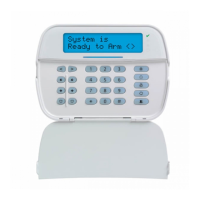Chapter 9
9.0 Managing Partitions
A partition is a limited area of the premises which operates independently from the other areas. Partitioning a system can be bene-
ficial if the property has outbuildings that need to be secured independently of a main area or if the home has a separate apartment.
Each partition can have its own keypad, or a keypad can have access to all partitions. User access to partitions is controlled via
access code. A master code can access the entire system and partitions, while a user code is limited to assigned partitions.
9.1 Partitions
Keypads can be configured to control an individual partition or all partitions.
Note:Access to this feature must be configured by installer.
9.1.1 Single Partition Operation
Single partition keypads provide access to alarm functionality for an assigned partition.
Single partition keypads behave as follows:
l Displays the set state of the partition.
l Displays open zones, if assigned to the partition the keypad is on.
l Displays bypassed zones and allows zone bypassing or creating bypass groups of zones assigned to the keypad partition.
l Displays system troubles (system low battery, system component faults/tampers).
l Displays alarms in memory that occurred on the partition.
l Allows the door chime to be Enabled/disabled.
l System test (sounds bells/PGMs assigned to the partition).
l Label programming (zone, partition and user labels for the partition).
l Command output controls (outputs assigned to the partition, or global outputs such as smoke detector reset).
l Temperatures.
9.1.2 Loaning a Keypad to Another Partition
Keypads can be loaned to operate on other partitions (LCD keypads only). When a keypad is loaned from either the global state or
from another partition, it may be configured to behave on the loaned partition just as it would if it was originally assigned there.
An access code must be entered before loaning a keypad to another partition. An access code is also required to perform any func-
tion on that partition. The status of each partition will be identified by a partition flag. For an explanation on partition flags, see the
following table.
To Loan a Keypad to Another Partition LCD Display
1. Press and hold the [#] key for 2 seconds and enter the access code.
1 2 3 4 5 6 7 8
R R - - - - - N
2. Select a partition by pressing and [*]. The keypad is temporarily loaned to
another partition. If the keypad is inactive for more than 30 seconds, it reverts to its
original partition.
PartitionFlags
LCD Display Flag Description
1 2 3 4 5 6 7 8
R X A ! E - - N
1-8 Partitionnumber
R Partitionisreadytobeset
X Partitionisinexitdelay
N Partitionisnotreadytobeset
! Partitionisinalarm
E Partitionisinentrydelay
- Partitionisnotconfigured
A Partitionisset
9.2 Fire and CO Zone Types
l If a Fire zone generates an alarm only the partition the fire zone is assigned to will go into alarm. Other partitions retain
their current state.
l If the [F] key on a global keypad is used to generate an alarm all enabled partitions will go into alarm.
l One or more fire keypads may be located on any partition.
l On alarm, the fire auto-scroll display appears on all partition keypads and on all global keypads. Fire alarm silence and
fire system reset may be done directly on any partition keypad. To silence a fire or CO alarm from a global keypad
requires that the global keypad be loaned to one of the partitions.
- 33 -

